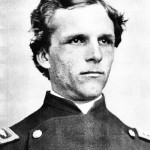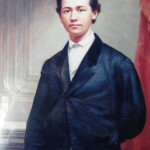Sons Of The Civil War
Soldiers from Hawaii, including Hawaiian royalty, fought in the American Civil War – who knew? This is their story, and of the documentary filmmaker and historical researcher who are working to produce a film on the subject
Nanette Napoleon and Todd Ocvirk were stunned to find out Hawaii residents fought in America’s Civil War. They are making an effort to make sure future generations aren’t as surprised.
- Todd Ocvirk and Nanette Napoleon go over research materials for their planned documentary
- Col. Samuel Chapman Armstrong | Hampton University archives
- Henry Ho‘olulu Pitman | Diane Spieler photo
- Ocvirk and Napoleon discuss their Civil War project | Anthony Consillio photo
Napoleon, a historical researcher, and Ocvirk, a writer/producer/director, have teamed up to create a documentary telling the story of the Hawaiians and Hawaii residents who served in what was then a foreign war. Their long-term goal is to create a DVD and study guide to help high school students better understand this unique time in Hawaii’s history.
Napoleon had her moment of discovery while researching the Dole Derby – a 1927 air race from California to Hawaii that resulted in the loss of six planes and the deaths of 10 people. While reading about the race in The Friend, a missionary newspaper, she stumbled upon a letter from Col. Samuel Chapman Armstrong, a Hawaii resident, who recounted meeting another Hawaii resident named Kealoha, a private in the Union Army.
“I read that article and I was like, ‘What? Hawaiians were in the Civil War. Are you kidding me?’ I said that out loud in the library and I immediately dropped the other project I was working on, and I just got so intrigued in that and it started me on this path.”
Ocvirk’s situation was similar. While visiting relatives buried at Punchbowl, he saw a plaque honoring Hawaii residents who served in the war.
“I literally had to stop. Hawaiians fought in the Civil War? I had never heard of that. I went to Kamehameha and I took Hawaiian history classes, and I had never heard of that, ever. I was completely blown away. I asked friends if they had ever heard of Hawaiians serving in the Civil War. Everyone said no.”
Such a connection with the independent nation of Hawaii seems odd at first, especially after King Kamehameha IV issued an Aug. 26, 1861, proclamation declaring neutrality in the war and sovereignty of the nation’s maritime property. However, the economy of the Islands was connected with the business interests of both sides, forcing the citizens of Hawaii to make a choice.
At the time, Hawaii’s economy depended heavily on the whaling industry, which was primarily based in the Northeastern U.S. Hawaiian males, being excellent sailors, were sought-after employees on whaling and merchant vessels. Many even relocated to New England.
To counter shipments of the valuable whale oil to its enemy, the Confederacy sent ships to sink or capture whaling vessels. The result was 26 whaling ships sunk, including those registered in Hawaii. Also, with Southern sugar supplies being cut off, the North turned to Hawaii to supply the valuable resource. Perhaps in an effort to support the side that was supporting them, the people of Hawaii showed their support by sewing American flags and bandages for Union troops.
They collected money for the war effort – Alexander Cartwright, the father of baseball, helped lead the drive. And while Hawaii residents fought on both sides, the vast majority of the more than 100 residents, including at least 34 Native Hawaiians, served in the black regiments in the Union Army and Navy.
Napoleon began her research 12 years ago, and four years later she decided to write a book with the goal of completing the work by her 62nd birthday. She didn’t make it. She hit the milestone a year ago, her attention now turned toward the movie. Along the way, she became involved in the effort to raise funds and create the very plaque that stoked her partner’s interest.
The pair joined forces two years ago. Ocvirk was in the process of collecting information about the war when mutual friends suggested he contact Napoleon, who by then was an expert on the subject.
“I was so blown away by the subject matter and that nobody knew about it that I felt compelled to do it and make a documentary film,” says Ocvirk.
The pair combined their expertise, she in history and he in filmmaking. She would provide the information and he would turn it into a proper script. Together they have hunted down sponsors to begin financing the $350,000 film. So far they’ve raised $20,000 from the Hawaii Council for the Humanities and Pacific Islanders in Communications, plus money left over from the Civil War commemorative plaque at Punchbowl.
Much of the money has gone to pay for research in Washington, D.C., Gettysburg and Huntington Library in California, which houses a large collection of Civil War documents.
“Anytime she gives me new information, and it doesn’t matter how small it is, it is mind-blowing for me because I am so interested in this topic. And, as a writer/filmmaker, I am always looking for a good story, good characters, something interesting, and this definitely jumped right out at me,” says Ocvirk. “When we went to Huntington Library, that was the first time I had ever really looked at old documents and letters, and I literally got chills looking through the vintage stuff that this guy has actually written himself. So it was very rewarding for me.”
The “guy” he refers to is Armstrong, a character worth studying.
Armstrong was the child of missionary parents. His father was the first director of public education in Hawaii and he opened the state’s first public schools.
“Growing up, Armstrong was very influenced by his father’s work in education. He would go on these horseback trips around the island to visit the schools, so he learned about education, Hawaiians and the educational system. That stuck with him. After the war, he heard about the Freedman’s Bureau (a federal program to help former slaves in areas such as education, health care and employment) and he wanted to be part of the education mission with the freed slaves.”
Armstrong, who was born on Maui in 1839 and would rise to the rank of brevet brigadier general, was assigned to the 9th Regiment, United States Colored Troops, and the 8th U.S. Colored Troops. While in command, he established a school to educate black soldiers, most of whom were denied an education as slaves.
After the war, Armstrong established the Hampton Normal and Agricultural Institute – now known as Hampton University – where black students could receive a college education. One of those students was Booker T. Washington.
Napoleon says the film focuses less on the war and its impact on Hawaii and more on people like Armstrong and Henry Ho’olulu Pitman, the son of High Chiefess Kimo’ole o Liliha. Pitman was captured near Fredericksburg, Va., in 1862 and sent to a prison camp where he died of “lung fever” at the age of 17. Finding out about Pitman was particularly important to Ocvirk.
“When I found out one of the veterans was of Hawaiian royalty, that to me was amazing.”
The film is set for release in 2015 to commemorate the war’s 150th anniversary. In the meantime, Napoleon and Ocvirk are continuing their fundraising efforts through the crowd-funding site Indigogo, which began June 19 and runs through July 19.
The pair has set a target goal of $70,000, which will pay for pre-production work, including the writing of the script. Donations can be made through Indiegogo or at the production’s web-site, hawaiisonsofthecivilwar.com.







